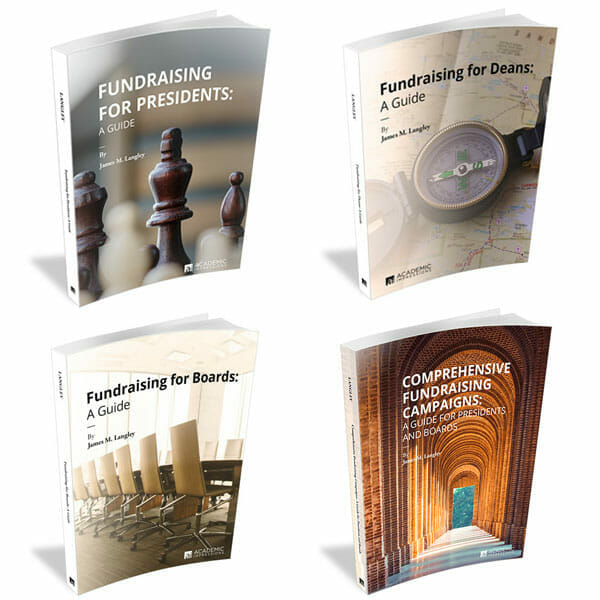
Series: Creating the Conditions for Support
Everyone is trying to raise more money. Rather than simply suggest the next tactic that can boost giving in the short-term, this series offers a more intensive look at the strategic thinking that drives philanthropic support: Why do donors give? How do institutions strengthen their core and emphasize initiatives worthy of support? How do we align strategic plans, strengths, and advancement strategy to create the conditions for ongoing and sustained support? In this series, distinguished current and past chief advancement officers apply their most innovative and creative thinking to this question.
Next in this series:
More than Dollars: How Many Opportunities Are You Missing with Your Alumni?
Engaging Women in Philanthropy: Practical Ways to Shift Our Approach
Checklist: Questions the Governing Board Must Ask Before Launching a Campaign
Given that annual alumni support nationally has been declining for 22 years and that less than one in ten alumni are currently giving back to their alma maters, it is clear that our core practices and the philosophies that underpin them need to change. In short, we need to elicit more and solicit less. And foremost among the thoughts we should be eliciting is why our alumni give to us or to other institutions. Learning more about the why of giving always strengthens our hand with, and our ties to, every kind of donor – prospect and current – and at any point in our relationship.
The Why of Giving: What We Need to Start Asking
The more we study the habits and decisions of individual philanthropists, particularly the most loyal and generous, the more we see how motivated they are by deeply personal experiences. For instance:
- When we interview an alum who has given generously to cancer research, we learn that she or a loved one has had a direct and searing experience with that disease.
- Or if we listen to a donor who has provided significant support for a business school, we discover he has a pronounced passion for a particular innovation or practice, which he believes was the key to his success and the lesson that he would most like to pass on to others.
But we only learn these things if we ask donors why they gave. The better we understand the personal why of giving, the more we can optimize the potential of each donor, steward their gifts in a way that is most meaningful to them, and increase the probability of their giving again.
Yet so many institutional leaders assume they understand why someone gave by looking at what they gave to – which might include scholarships, programmatic initiatives, or capital improvements. These are only categories of giving, not motivations for giving.
If we delve more deeply, we see people giving within those categories for a host of personal reasons. For instance, one donor might provide funding for a scholarship to help those in financial need while another is interested in rewarding those who have demonstrated exceptional academic achievement. Look more deeply still and we see some donors who give in the name of scholarship support to foster the ascendancy of a specific ethnic populations or to promote gender equity, and others who are primarily interested in supporting those who study a specific discipline or intend to pursue a specific career. If we ask them why, we learn that they are motivated by “what life has taught me” and that they see philanthropy as a means of passing on those lessons to a younger generation.
With this insight, let us look at three donor populations where we may be missing the greatest opportunities:
- Current donors who give more to other organizations
- Alumni who give generously to other institutions but not ours
- First-time donors
1. Alumni Who Give to Our School But Give More Generously to Other Organizations
This donor group is well worth our attention because they have already proven themselves as philanthropic and have demonstrated some confidence in our organization. If we understood why they are giving more to another organization than they are to us, we might discover ways to invite their greater giving to our institution.
Scenario. For instance, suppose we see that one of our most generous donors is making consistently larger contributions to a local charter school. We find the first opportunity to speak to this donor and learn that his support of that charter school is rooted in his own childhood educational struggles, which were surmounted when one high school teacher realized he was not “disabled” but that instead he employed unusual ways of processing information and solving problems. Because of the help of this one teacher, he says, he became an exceptional learner and went on to great success. Since that teacher died before he achieved success, he began looking for ways he could “give back.” When he learned about a charter school that demonstrated how it was having a transformative impact on previously underperforming students by offering a range of “individual learning modalities,” he saw his opportunity to help others as he had been helped.
Response to the Scenario. With that new insight into why that donor gives, we begin exploring what our institution is doing in the name of pedagogical innovation. We discover that we have several professors whose research and practice has placed them at the forefront of the “learning revolution,” and one whose research has been applied in numerous high school settings and led to substantial improvements in student performance. Now we have the means to engage this generous donor with a powerful line of reasoning: “May we speak with you about a way you could not only help one charter high school but trigger a wave of innovation across secondary education by helping us create an Institute of Advanced Teaching Practices?”
2. Alumni Who Give Generously to Other Institutions But Have Never Given to Our School
Once again, we can improve our fundraising efficiency and sustain higher levels of giving by focusing on those who are already wired to give, rather than chasing those with no history of giving. In the case of “otherwise philanthropic” alumni, we know that they, at minimum, are familiar with us, and we hope that they maintain a regard for the experiences they had with us. However, we won’t be effective in re-engaging them if we begin with a sales pitch.
Instead, we should reach out to let them know that their alma mater takes great pride in their philanthropy and to request an opportunity to discuss what has motivated them to give and what their alma mater can learn from their experience.
Scenario. Our alumni magazine runs a feature on an African American graduate who created a highly successful beauty care business. She then established a multi-million dollar endowment to provide full scholarships for any student who graduates with a B average or better from an inner-city school in Dayton, Ohio. A scan of our donor records reveals she has never given back to her alma mater.
Response to the Scenario. We write her a note saying how impressed we are by her success and her philanthropic leadership. We request an appointment, stressing our reason is to learn from her professional and philanthropic successes so that we might help others to follow in her footsteps. She responds by e-mail, agreeing to a meeting, but adds, “I hope you are serious about wanting to learn.”
During that meeting, we discover both a barrier and a gateway to her giving to her alma mater:
- The barrier is her memory of struggling to adapt to our campus culture. As the first in her family to go to college, she poignantly describes what it was like to navigate an entirely new world in which it was “just assumed” that she could find her way through the jargon of orientation literature and through a mystifying array of course offerings.
- The gateway is her aspiration to not only provide scholarship support for students but to fund programs at colleges and universities that help first-generation students of color “translate and apply” the reams of information provided to them after admission.
Learning this, we begin lowering the barrier by acknowledging that the school “has come a long way since then.” We cite higher rates of admission, persistence and graduation for African American students in the past decade. We also widen the gateway by demonstrating which services have led to those achievements and where even greater success has been curtailed by inadequate funding.
Seeking to understand a donor’s deepest motivations is becoming increasingly important because we are seeing more individual donors acting like private foundations. In other words, their annual giving decisions are driven by a predetermined set of values-driven preferences. For these donors, institutions who ask for a gift without first asking about those preferences are eliminated from consideration.
3. First-Time Donors
There is nothing more fundamental to building a donor profile than logging the why of giving. In keeping records and anecdotes of why alumni, parents, faculty, staff and friends give, we can:
- Train our telephone solicitors to ask first-time donors what motivated them to give to their alma mater; this also mitigates one of the principle complaints about annual fund callers: “They don’t know who I am.”
- Steward these donors more personally by letting them know what we are doing to advance the cause or purpose about which they care the most.
- Pick up more gracefully on that personal conversation when it is time to solicit again.
If we can find the time to solicit thousands of alumni each year, we can certainly find the time to ask thousands of them why they have chosen to give. If we just take the few minutes to do so, our ability to convert first-time donors to repeat givers and eventually loyal donors will be greatly enhanced.
More from Jim Langley
Jim Langley is the author of a series of powerful fundraising guides for campus leaders: Fundraising for Presidents, Fundraising for Deans, Fundraising for Boards, and Comprehensive Fundraising Campaigns.

“This is is a treasure trove of great advice, forward-thinking reflections, and the tough, but much needed questions that presidents, boards, vice presidents and deans need to ask one another before embarking on a fundraising campaign.”
Matthew T. Lambert, Vice President for University Advancement, William & Mary


